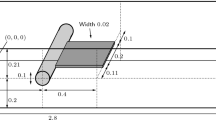Abstract
We compare the relative performance of monolithic and segregated (partitioned) solvers for large- displacement fluid–structure interaction (FSI) problems within the framework of oomph-lib, the object-oriented multi-physics finite-element library, available as open-source software at http://www.oomph-lib.org. Monolithic solvers are widely acknowledged to be more robust than their segregated counterparts, but are believed to be too expensive for use in large-scale problems. We demonstrate that monolithic solvers are competitive even for problems in which the fluid–solid coupling is weak and, hence, the segregated solvers converge within a moderate number of iterations. The efficient monolithic solution of large-scale FSI problems requires the development of preconditioners for the iterative solution of the linear systems that arise during the solution of the monolithically coupled fluid and solid equations by Newton’s method. We demonstrate that recent improvements to oomph-lib’s FSI preconditioner result in mesh-independent convergence rates under uniform and non-uniform (adaptive) mesh refinement, and explore its performance in a number of two- and three-dimensional test problems involving the interaction of finite-Reynolds-number flows with shell and beam structures, as well as finite-thickness solids.
Similar content being viewed by others
References
Förster C, Wall W, Ramm E (2007) Artificial mass instabilities in sequential staggered coupling of nonlinear structures and incompressible viscous flows. Comput Methods Appl Mech Eng 196: 1278–1293
Fernandez MA, Gerbeau J-F, Grandmont C (2007) A projection semi-implicit scheme for the coupling of an elastic structure with an incompressible fluid. Int J Numer Methods Eng 69: 794–821
Heil M, Hazel AL (2006) oomph-lib—An object-oriented multi-physics finite-element library. In: Schafer M, Bungartz H-J (eds) Fluid–structure interaction. Springer (Lecture Notes on Computational Science and Engineering), pp 19–49
Irons BM, Tuck RC (1969) A version of the Aitken accelerator for computer iteration. Int J Num Methods Eng 1: 275–277
Jensen OE, Heil M (2003) High-frequency self-excited oscillations in a collapsible-channel flow. J Fluid Mech 481: 235–268
Demmel JW, Eisenstat SC, Gilbert JR, Li XS, Liu JWH (1999) A supernodal approach to sparse partial pivoting. SIAM J. Matrix analysis and applications 20:720-755. http://crd.lbl.gov/~xiaoye/SuperLU/
Heil M (2004) An efficient solver for the fully coupled solution of large-displacement fluid-structure interaction problems. Comput Methods Appl Mech Eng 193: 1–23
Bertram CD, Tscherry J (2006) The onset of flow-rate limitation and flow-induced oscillations in collapsible tubes. J Fluids Struct 22: 1029–1045
Elman HC, Silvester DJ, Wathen AJ (2006) Finite elements and fast iterative solvers with applications in incompressible fluid dynamics. Oxford University Press, New York
Turek S, Hron J, (2007) Proposal for numerical benchmarking of fluid–structure interaction between an elastic object and laminar incompressible flow. In: Schafer M, Bungartz H-J (eds) Fluid–structure interaction. Lecture Notes on Computational Science and Engineering. Springer, Heidelberg. pp 371–385
hypre—High performance preconditioning library. Center for Applied Scientific Computing at Lawrence Livermore National Laboratory. http://www.llnl.gov/CASC/hypre/software.html
Trilinos. Sandia National Laboratories. http://trilinos.sandia.gov/
Author information
Authors and Affiliations
Corresponding author
Rights and permissions
About this article
Cite this article
Heil, M., Hazel, A.L. & Boyle, J. Solvers for large-displacement fluid–structure interaction problems: segregated versus monolithic approaches. Comput Mech 43, 91–101 (2008). https://doi.org/10.1007/s00466-008-0270-6
Received:
Accepted:
Published:
Issue Date:
DOI: https://doi.org/10.1007/s00466-008-0270-6



